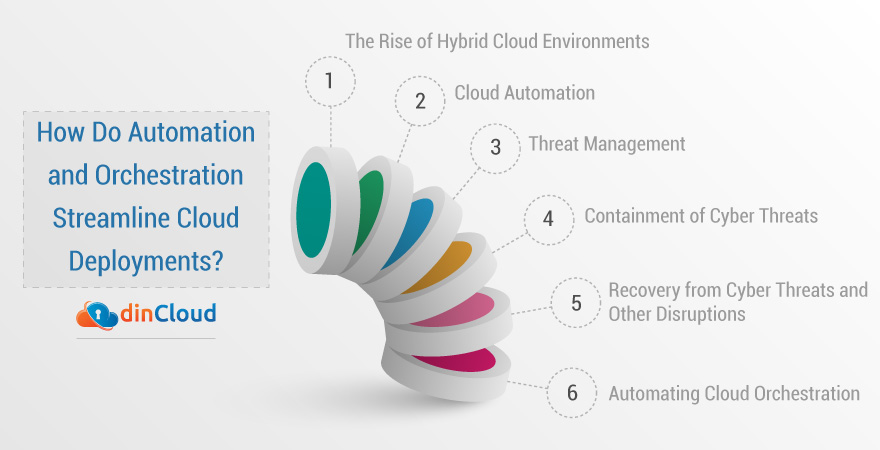Enterprises are constantly increasing their reliance on cloud powered solutions for their workloads. Not long ago, organizations were not very comfortable with the idea of moving their mission critical workloads to the public cloud.

Fast forward to the present environment and all this has changed. The manner in which leading Cloud Service Providers (CSP) like dinCloud managed an unprecedented demand for their solutions is phenomenal.
Enterprises are now comfortable with moving even their mission critical workloads to the cloud, with both assurance and confidence. The two factors that have played a leading role in this major change are Cloud Automation and Orchestration.
The Rise of Hybrid Cloud Environments
Over the past couple years or so, we have witnessed an unprecedented rise in hybrid cloud environments. Most enterprises find the hybrid cloud as the sweet spot between full on premise environments and completely cloud driven infrastructures.
The hybrid cloud is also very useful in enabling enterprises achieve a smooth transition to the Cloud in the first place. It is mainly due to the hybrid cloud that migrating entities are able to achieve a smooth and seamless transition, with minimal to no disruptions.
Hybrid cloud environments also give enterprises strong protection from an imminent vendor lock-in. In fact, this factor alone acts as a major deterrent for organizations that are prospecting for cloud solutions out there in the market.
Related: How to Build a Robust IT Infrastructure via Digitalization and Automation?
Cloud Automation
By leveraging automation in cloud environments, enterprises are able to put repetitive processes within cloud environments on “auto pilot”. Here are some of the core areas where cloud automation really pays huge dividends.
Threat Management
As the role of cloud services increases in enterprise workloads, there is also a corresponding rise in the threat surface. So, basic and human centric security tools as well as protocols are simply no longer adequate to protect from present day cyber threats.
By automating threat perception and management within cloud environments, enterprises are in a much better position to identify as well as prevent cyber threats. Automated security tools are able to identify anomalies before they actually become threats.
Containment of Cyber Threats
No matter how secure a cloud environment may be, the possibility of a cyber attack getting through can never be completely ruled out. So, enterprises and cloud providers alike have to prepare themselves for this rare eventuality.
Automation plays a great role in containing the damages that a potential attack can inflict on cloud environments. As threats are being identified and responded to in real time via automated tools, the possibility of a threat remaining undetected is nearly ruled out.
Related: Hyper-Automation to Witness Massive Growth till 2022
Recovery from Cyber Threats and Other Disruptions
This is yet another area where automation pays off in a big way. One of the most painful consequences of any serious cyber threat is disruption of mission critical processes. With human based tools, it is nearly impossible to gauge the true extent of damage.
With automation however, an enterprise that is affected by a cyber attack can immediately identify and quantify the areas that could have been impacted by an attack. This makes it a lot easier and quicker to restore operations, even if they do face any disruption.
Automating Cloud Orchestration
You can define cloud orchestration as the set of all those processes which enable the cohesive flow of workloads within a cloud environment and elsewhere. This also greatly simplifies the task of allocating workloads across on premise and cloud environments.
The end goal enterprises achieve by automating cloud orchestration is highly efficient processes. This in turn reduces latency and improves organizational efficiency. With automated workflows, their replication across environments is also very easy.
Related: The Retail Sector Using Zero Trust and Automation to Bolster Security
Conclusion
With cloud automation and orchestration, it becomes much easier for enterprises to deploy hybrid cloud environments. The advantages of automation, down the road, far exceed the initial cost and road blocks this process may face during its initial stages.
Contact dinCloud for reliable, scalable and secure cloud solutions for your enterprise needs.


